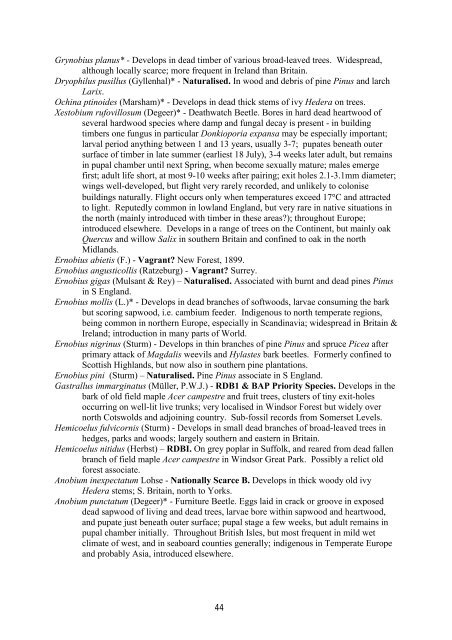Crustacea: Copepoda - Cerambycoidea.com
Crustacea: Copepoda - Cerambycoidea.com
Crustacea: Copepoda - Cerambycoidea.com
Create successful ePaper yourself
Turn your PDF publications into a flip-book with our unique Google optimized e-Paper software.
Grynobius planus* - Develops in dead timber of various broad-leaved trees. Widespread,<br />
although locally scarce; more frequent in Ireland than Britain.<br />
Dryophilus pusillus (Gyllenhal)* - Naturalised. In wood and debris of pine Pinus and larch<br />
Larix.<br />
Ochina ptinoides (Marsham)* - Develops in dead thick stems of ivy Hedera on trees.<br />
Xestobium rufovillosum (Degeer)* - Deathwatch Beetle. Bores in hard dead heartwood of<br />
several hardwood species where damp and fungal decay is present - in building<br />
timbers one fungus in particular Donkioporia expansa may be especially important;<br />
larval period anything between 1 and 13 years, usually 3-7; pupates beneath outer<br />
surface of timber in late summer (earliest 18 July), 3-4 weeks later adult, but remains<br />
in pupal chamber until next Spring, when be<strong>com</strong>e sexually mature; males emerge<br />
first; adult life short, at most 9-10 weeks after pairing; exit holes 2.1-3.1mm diameter;<br />
wings well-developed, but flight very rarely recorded, and unlikely to colonise<br />
buildings naturally. Flight occurs only when temperatures exceed 17�C and attracted<br />
to light. Reputedly <strong>com</strong>mon in lowland England, but very rare in native situations in<br />
the north (mainly introduced with timber in these areas?); throughout Europe;<br />
introduced elsewhere. Develops in a range of trees on the Continent, but mainly oak<br />
Quercus and willow Salix in southern Britain and confined to oak in the north<br />
Midlands.<br />
Ernobius abietis (F.) - Vagrant? New Forest, 1899.<br />
Ernobius angusticollis (Ratzeburg) - Vagrant? Surrey.<br />
Ernobius gigas (Mulsant & Rey) – Naturalised. Associated with burnt and dead pines Pinus<br />
in S England.<br />
Ernobius mollis (L.)* - Develops in dead branches of softwoods, larvae consuming the bark<br />
but scoring sapwood, i.e. cambium feeder. Indigenous to north temperate regions,<br />
being <strong>com</strong>mon in northern Europe, especially in Scandinavia; widespread in Britain &<br />
Ireland; introduction in many parts of World.<br />
Ernobius nigrinus (Sturm) - Develops in thin branches of pine Pinus and spruce Picea after<br />
primary attack of Magdalis weevils and Hylastes bark beetles. Formerly confined to<br />
Scottish Highlands, but now also in southern pine plantations.<br />
Ernobius pini (Sturm) – Naturalised. Pine Pinus associate in S England.<br />
Gastrallus immarginatus (Müller, P.W.J.) - RDB1 & BAP Priority Species. Develops in the<br />
bark of old field maple Acer campestre and fruit trees, clusters of tiny exit-holes<br />
occurring on well-lit live trunks; very localised in Windsor Forest but widely over<br />
north Cotswolds and adjoining country. Sub-fossil records from Somerset Levels.<br />
Hemicoelus fulvicornis (Sturm) - Develops in small dead branches of broad-leaved trees in<br />
hedges, parks and woods; largely southern and eastern in Britain.<br />
Hemicoelus nitidus (Herbst) – RDBI. On grey poplar in Suffolk, and reared from dead fallen<br />
branch of field maple Acer campestre in Windsor Great Park. Possibly a relict old<br />
forest associate.<br />
Anobium inexpectatum Lohse - Nationally Scarce B. Develops in thick woody old ivy<br />
Hedera stems; S. Britain, north to Yorks.<br />
Anobium punctatum (Degeer)* - Furniture Beetle. Eggs laid in crack or groove in exposed<br />
dead sapwood of living and dead trees, larvae bore within sapwood and heartwood,<br />
and pupate just beneath outer surface; pupal stage a few weeks, but adult remains in<br />
pupal chamber initially. Throughout British Isles, but most frequent in mild wet<br />
climate of west, and in seaboard counties generally; indigenous in Temperate Europe<br />
and probably Asia, introduced elsewhere.<br />
44

















